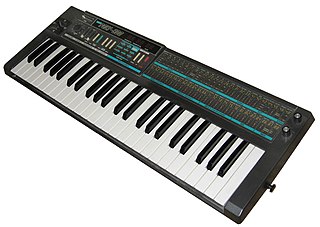
The Korg Poly-800 is an 8-voice analog synthesizer released by Korg in 1983. Its initial list price of $795 made it the first fully programmable polyphonic synthesizer that sold for less than $1,000. It was designed for portability, featuring battery power and a lightweight design that allowed the user to play with it strapped around their neck. It utilized digitally controlled oscillators (DCOs), and was a paraphonic synth with a single filter shared between its eight voices.
The Yamaha AN1x is a DSP-based analog modeling synthesizer, produced by Yamaha Corporation from 1997 to 1998, and was marketed as an "analog physical modelling control synthesizer".

The Jupiter-8, or JP-8, is an eight-voice polyphonic analog subtractive synthesizer introduced by Roland Corporation in early 1981.

The Realistic Concertmate MG-1 is an analog synthesizer manufactured by Moog Music in 1981 and sold by Radio Shack from 1982 to 1983 under their "Realistic" brand name. It was produced without some standard Moog features, such as pitch and modulation wheels, as a cost-cutting measure aimed at achieving a lower price for the consumer market. The synthesizer also featured a pair of pass-through RCA jacks, which allowed users to mix radio or records into the final live synthesized sound output.
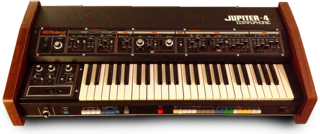
The Roland Jupiter-4 (JP-4) was an analog synthesizer manufactured by the Roland Corporation between 1978 and 1981. It was notable as the company's first self-contained polyphonic synthesizer, and for employing digital control of analog circuits, allowing for such features as programmable memory, voice assignment modes, an arpeggiator, polyphonic portamento and others.

The microKORG is a MIDI-capable digital synthesizer/vocoder from Korg featuring DSP-based analog modelling. The synthesizer is built in such a way that it is essentially a Korg MS-2000 with a programmable step arpeggiator, a less advanced vocoder, lack of motion sequencing, lack of an XLR microphone input, and in a smaller case with fewer real-time control knobs.

The Korg MS-20 is a patchable semi-modular monophonic analog synthesizer which Korg released in 1978 and which was in production until 1983. It was part of Korg's MS series of instruments, which also included the single oscillator MS-10, the keyboardless MS-50 module, the SQ-10 sequencer, and the VC-10 Vocoder. Additional devices included the MS-01 Foot Controller, MS-02 Interface, MS-03 Signal Processor, and MS-04 Modulation Pedal.
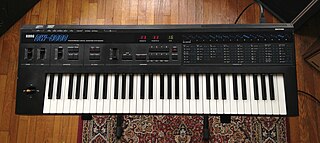
The Korg DW-8000 is a polyphonic hybrid digital-analog synthesizer released in 1985. It blends digital waveforms with an analog filter and amplifier, followed by a digital delay for adding echo effects. It boasts eight-note polyphony and its keyboard is equipped with velocity sensitivity and aftertouch.

The Korg Prophecy is a monophonic synthesizer released by Korg in 1995. Korg's first monophonic synthesizer since the Mono/Poly, the Prophecy employs Korg's Multi Oscillator Synthesis System (MOSS), which features digital oscillators capable of emulating synthesis techniques such as analog synthesis, FM and physical modelling. Emphasized for its portability, expressiveness, and engaging playability, a distinctive feature of the Prophecy is its multifunctional Wheel 3, nicknamed the 'log'.
The Memorymoog is a polyphonic electronic music synthesizer manufactured by Moog Music from 1982 to 1985, the last polyphonic synthesizer to be released by Moog Music before the company declared bankruptcy in 1987. While comparable to other polyphonic synthesizers of the time period, such as the Sequential Circuits Prophet-5 and Oberheim OB-Xa, the Memorymoog distinguished itself with an additional, 3rd audio oscillator per voice and greater preset storage capacity.
The Korg Poly-61(PS-61) is an analog programmable polyphonic synthesizer released by Korg in 1982, as a successor to the Polysix. It was the first affordable synthesizer to feature two oscillators per voice, and was Korg's first largely "knobless" synthesizer, replacing the traditional knobs and switches found on the Polysix with a series of parameter selectors and two incrementing buttons that allowed the user to program sounds one section at a time.

The Oberheim OB•12 is a Virtual Analog synthesizer, designed and realised by the Italian musical instrument manufacturer Viscount, in production between 2000 and 2005.

Korg MS-10 is an analogue synthesizer created by Korg in 1978. Unlike its bigger brother, the Korg MS-20, the MS-10 only has one VCO, one VCF and one envelope generator. It is monophonic and has 32 keys.
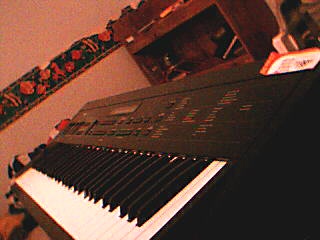
The Korg DS-8 is a digital eight-voice FM synthesizer released by Korg in 1987. Following an agreement with Yamaha for access to its research and development facilities, it was designed using Yamaha components and constructed under a licensing agreement. It introduced an analog-style interface for controlling FM sounds and could play different patches on each of its eight voices, marking it as Korg's first multi-timbral MIDI synthesizer. Accompanying its launch was the Korg 707, a more portable version of the DS-8, lacking digital effects but equipped with strap pegs for keytar performance.

The Korg DW-6000 is a polyphonic hybrid digital-analog synthesizer released in 1985. It blends digital waveforms with an analog filter and amplifier, also incorporating a chorus effect to create an enriched analog sound. The DW-6000 features six-note polyphony and was quickly succeeded by the DW-8000, also released in 1985, which introduced a velocity sensitive keyboard with aftertouch, a built-in arpeggiator, increased polyphony and waveforms, and substituted the chorus effect with a digital delay effect.

The AX60 is a polyphonic analogue keyboard synthesizer manufactured by Akai Professional in the mid-1980s. It was Akai's answer to the popular Roland Juno series synthesizers. The AX60 uses voltage-controlled analogue oscillators and filter circuitry based on the Curtis Electronics CEM 3394 integrated circuit.

The Korg Z1 is a digital synthesizer released by Korg in 1997. The Z1 built upon the foundation set by the monophonic Prophecy released two years prior by offering 12-note polyphony and featuring expanded oscillator options, a polyphonic arpeggiator and an XY touchpad for enhanced performance interaction. It was the world's first multitimbral physical modelling synthesizer.

The Korg Minilogue is a polyphonic analog synthesizer released in 2016 by Korg. It offers users four-voice polyphony with two analog VCOs per-voice and was designed to be affordable. It was designed by Korg engineer and synthesizer designer Tatsuya Takahashi, who said "the concept of the Minilogue was to build an analog synthesizer that doesn't rely on the fame and success of an old synth".
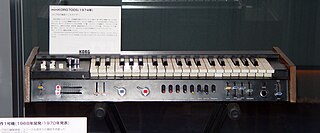
The miniKORG 700 is a monophonic analog synthesizer released by Korg in 1973, marking their entry into mass-produced synthesizers and their first monophonic synthesizer. It was initially designed to be placed on top of an organ, so its controls are located below the keyboard facing towards the performer. An updated model, the miniKORG 700S, was launched in 1974, introducing a second oscillator that could be detuned, along with additional sustain and vibrato controls.
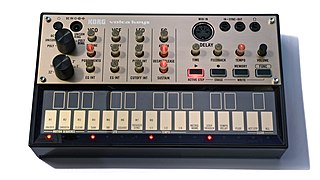
The Volca Keys is a analogue synthesizer manufactured by the Japanese music technology company Korg. It was announced in April 2013 at MusikMesse and was at the time one of the few affordable analogue synthesizers available. The Volca Keys uses subtractive synthesis to create sounds and is three-note paraphonic, meaning that it can play chords with all voices sharing a single voltage-controlled filter (VCF).


















